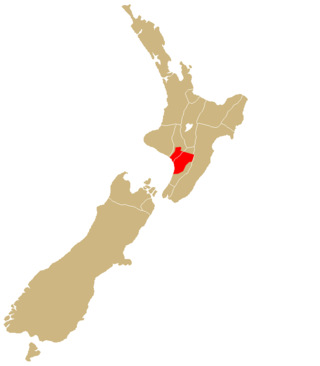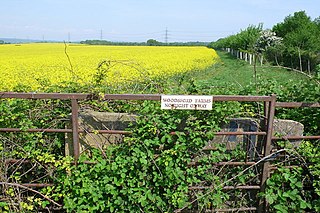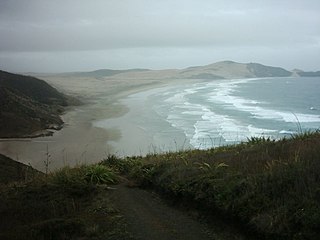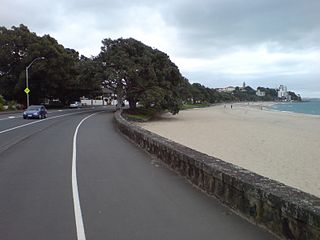The New Zealand foreshore and seabed controversy is a debate in the politics of New Zealand. It concerns the ownership of the country's foreshore and seabed, with many Māori groups claiming that Māori have a rightful claim to title. These claims are based around historical possession and the Treaty of Waitangi. On 18 November 2004, the New Zealand Parliament passed a law which deems the title to be held by the Crown. This law, the Foreshore and Seabed Act 2004, was enacted on 24 November 2004. Some sections of the Act came into force on 17 January 2005. It was repealed and replaced by the Marine and Coastal Area Act 2011.

Te-Oneroa-a-Tōhē / Ninety Mile Beach is on the western coast of the far north of the North Island of New Zealand. The beach is actually 88 kilometres long. Its southern end is close to the headland of Tauroa Point, to the west of Ahipara Bay, near Kaitaia. From there it sweeps briefly northeast before running northwest along the Aupouri Peninsula for the majority of its length. It ends at Tiriparepa / Scott Point, 5 kilometres (3 mi) south of Cape Maria van Diemen and about 10 kilometres (6 mi) south of Cape Reinga / Te Rerenga Wairua.
Udal law is a Norse-derived legal system, found in Shetland and Orkney in Scotland, and in Manx law in the Isle of Man. It is closely related to Odelsrett; both terms are from Proto-Germanic *Ōþalan, meaning "heritage; inheritance".

Ngāti Apa is a Māori iwi (tribe) in Rangitikei District of New Zealand. Its rohe extend between the Mangawhero, Whangaehu, Turakina and Rangitīkei rivers. This area is bounded by Whanganui River in the north-west, and Manawatū River in the south-east. The marae in this district include Tini wai tara, Whangaehu, Kauangaroa, and Parewanui.

Takaparawhau / Bastion Point is a coastal piece of land in Ōrākei, Auckland, New Zealand, overlooking the Waitematā Harbour. The area is significant in New Zealand history as the site of protests in the late 1970s by Māori against forced land alienation by Pākehā. Takaparawhau is now the site of the private Ōrākei Marae, the public Michael Joseph Savage Memorial, and privately-owned reserve land that is accessible to the public.

Aboriginal title is a common law doctrine that the land rights of indigenous peoples to customary tenure persist after the assumption of sovereignty under settler colonialism. The requirements of proof for the recognition of aboriginal title, the content of aboriginal title, the methods of extinguishing aboriginal title, and the availability of compensation in the case of extinguishment vary significantly by jurisdiction. Nearly all jurisdictions are in agreement that aboriginal title is inalienable, and that it may be held either individually or collectively.
The Māori protest movement is a broad indigenous-rights movement in New Zealand. While there were a range of conflicts between Māori and European immigrants prior to the signing of the Treaty of Waitangi in 1840, the signing provided a legal context for protesting, as the Treaty of Waitangi made New Zealand a British colony with British law and governance applying. The British authorities had drafted the Treaty with the intention of establishing a British Governor of New Zealand, recognising Māori ownership of their lands, forests and other possessions, and giving Māori the rights of British subjects. However, the Māori and English texts of the Treaty differ in meaning significantly; particularly in relation to the meaning of having and ceding sovereignty. These discrepancies, and the subsequent colonisation by Pākehā settlers led to disagreements in the decades following the signing, including full-out warfare.

Te Ture Whenua Māori Act 1993 is a statute of the Parliament of New Zealand to "reform the laws relating to Māori land in accordance with the principles set out in the Preamble". These principles "reaffirm" the Treaty of Waitangi "relationship between the Māori people and the Crown" and "recognise that land is taonga tuku iho of special significance to Māori people". To that end, the principles "promote the retention of ... land in the hands of its owners, their whanau, and their hapu, and to protect wahi tapu". Further, they "facilitate the occupation, development, and utilisation of that land for the benefit of its owners, their whanau, and their hapu".

The Māori Land Court is the specialist court of record in New Zealand that hears matters relating to Māori land.

Ngāti Tama is a historic Māori iwi of present-day New Zealand which whakapapas back to Tama Ariki, the chief navigator on the Tokomaru waka. The iwi of Ngati Tama is located in north Taranaki around Poutama. The Mōhakatino river marks their northern boundary with the Tainui and Ngāti Maniapoto iwi. Titoki marks the southern boundary with Ngati Mutunga. The close geographical proximity of Tainui's Ngati Toa of Kawhia and Ngati Mutunga explains the long, continuous, and close relationship among the three Iwi.

Right of way is the legal right, established by grant from a landowner or long usage, to pass along a specific route through property belonging to another. A similar right of access also exists on land held by a government, lands that are typically called public land, state land, or Crown land. When one person owns a piece of land that is bordered on all sides by lands owned by others, an easement may exist or might be created so as to initiate a right of way through the bordering land.
Wi Parata v Bishop of Wellington was a New Zealand court case of 1877 which ruled that the Treaty of Waitangi was a "simple nullity" having been signed by "primitive barbarians".
The Marine and Coastal Area Act 2011 is an Act of the New Zealand Parliament created to replace the Foreshore and Seabed Act 2004. It was brought in by the fifth National government and creates a sui generis property class for the marine and coastal area, in which it is vested in no one. This is in contrast to the Foreshore and Seabed Act 2004 in which the foreshore and seabed were vested in the Crown.

Muriwhenua are a group of northern Māori iwi, based in Te Hiku o te Ika, the northernmost part of New Zealand's North Island. It consists of six iwi, Ngāti Kurī, Ngāi Takoto, Te Pātū, Ngāti Kahu, Te Aupōuri and Te Rarawa, with a combined population of about 34,000 people. The spiritually significant Hokianga Harbour, located just to the south of the Maungataniwha Range, is of special significance to the Muriwhenua people.
Hāmi Te Māunu was a rangatira of Ngāti Mutunga who was born in 1823 in north Taranaki. He was also known as Hamuera Koteriki and Hamiora Te Herepounamu.

Tamaki Drive is the coastal road which follows the contours of the Waitematā Harbour, Auckland, New Zealand. The road links the suburbs Ōrākei, Mission Bay, and Kohimarama ending in Saint Heliers providing easy access to the local beaches. Tamaki Drive was completed in 1932 and incorporates The Strand, Bice Esplanade and, what was once part of the old Kohimarama Road. It is also referred to as the Waterfront Road. Tamaki Drive is a flat road around 8 km long and popular with walkers, runners and roller skaters, and includes a dedicated cycle lane. Those travelling along Tamaki Drive can find scenic highlights and peaceful views across the harbour to the volcanic island Rangitoto. The cliffs backing onto Tamaki Drive are made of Waitemata Sandstone strata clothed in places with pohutukawa. These trees seem to flower out of season, because these are actually Kermadec pohutukawa with small distinctive roundish leaves.

New Zealand Maori Council v Attorney-General, also known as the "Lands" case or "SOE" case, was a seminal New Zealand legal decision marking the beginning of the common law development of the principles of the Treaty of Waitangi.

Paki v Attorney-General was a case in the Supreme Court of New Zealand that considered whether “usque ad medium filum aquae”, the common law presumption that the purchaser of land adjoining a stream or river also obtains ownership of the waterway to its mid-point applied to the Waikato riverbed adjoining blocks of land at Pouakani, near Mangakino. For differing reasons the Supreme Court unanimously held that the "mid-point presumption" did not apply and "decided that it had not been shown that title determination to the Pouakani land blocks had affected ownership of the riverbed".

Ngati Apa v Attorney-General was a landmark legal decision that sparked the New Zealand foreshore and seabed controversy. The case arose from an application by eight northern South Island iwi for orders declaring the foreshore and seabed of the Marlborough Sounds Maori customary land. After lower court decisions and consequent appeals in the Maori Land Court, the Maori Appellate Court and the High Court; the Court of Appeal unanimously held that the Maori Land Court had jurisdiction to determine whether areas of foreshore and seabed were Maori customary land or not. The court also held that, "The transfer of sovereignty did not affect customary property. They are interests preserved by the common law until extinguished in accordance with the law". The effect of the decision was subsequently overturned by the Foreshore and Seabed Act 2004.

R v Symonds(The Queen v Symonds) incorporated the concept of Aboriginal title into New Zealand law and upheld the Government's pre-emptive right of purchase to Māori land deriving from the common law and expressed in the Treaty of Waitangi. Although the Native Lands Act 1862 waived Crown pre-emption, the notion of Aboriginal title has been revived in the 20th century to deal with Māori property rights.










